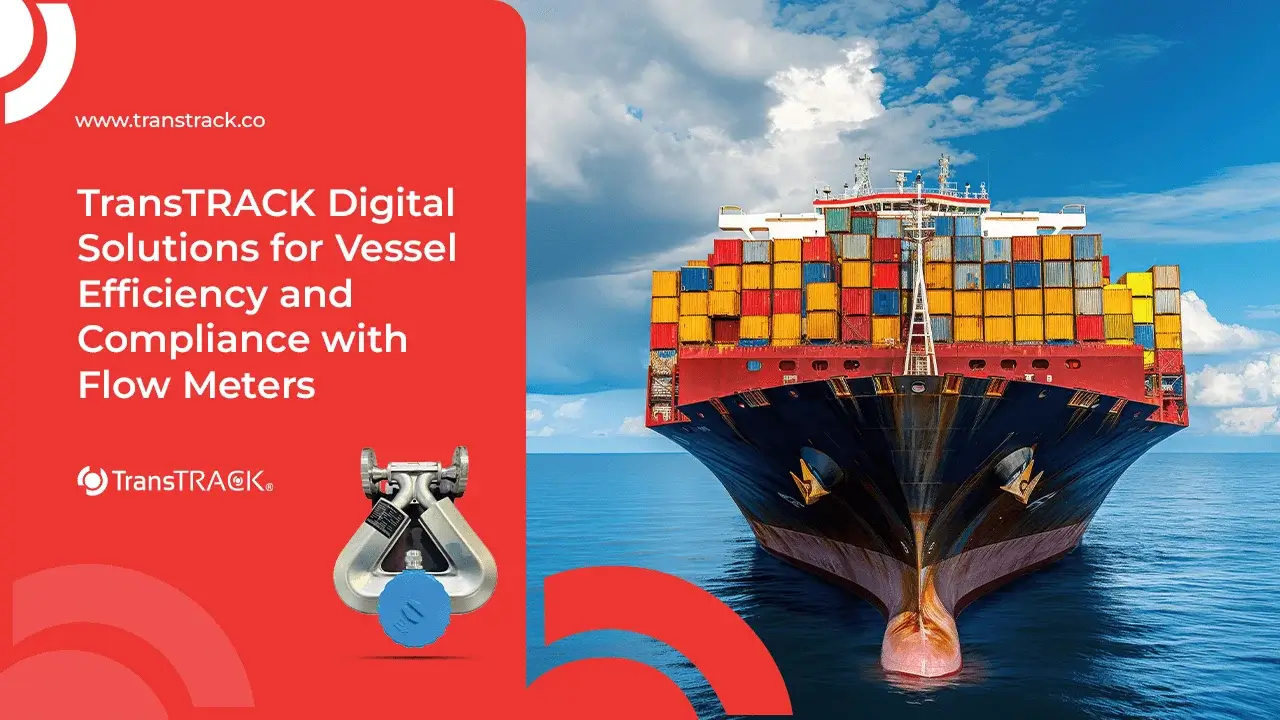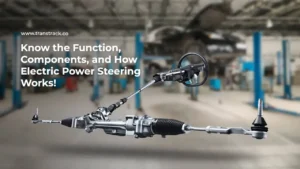TransTRACK Digital Solutions for Vessel Efficiency and Compliance with Flow Meters
Posted on June 26, 2025 by Nur Wachda Mihmidati

In the modern maritime industry, efficient and accurate vessel management relies heavily on advanced monitoring technology. One of the most important aspects is the real-time measurement and monitoring of fuel consumption and vessel operational fluids. For this reason, the use of high-quality flow meters integrated with ship monitoring systems is key in improving efficiency, safety, and regulatory compliance.
TransTRACK comes with an integrated solution that combines high-tech Coriolis flow meters with a comprehensive Vessel Monitoring System (VMS) platform. The system not only provides accurate data on fuel usage, but also integrates critical information such as high seas weather monitoring-providing the full control and insight required for optimal vessel operations. Check out the following article for more details!
What is a Flow Meter in the Context of the Maritime Industry?
A flow meter, or flow measurement device, is a device used to measure the flow rate of a liquid or gas in a system. In the context of the maritime industry, flow meters have a very important role, especially for managing and monitoring the use of fuels, lubricants, ballast water, fresh water, as well as other liquids on ships or port facilities.
Common Problems in Ship Fluid Management
The management of shipboard fluids, such as fuels, lubricants, ballast water, and other technical fluids, is a crucial aspect of efficient and safe maritime operations. But in practice, many technical and operational challenges often arise due to sub-optimal systems or monitoring technologies that have not been integrated. Here are some common problems that are often encountered in fluid management on ships:
1. Fuel Measurement Inaccuracy
- Problem: Inaccurate manual or sensor measurements can lead to erroneous fuel consumption data.
- Impact: Fuel wastage, emissions reporting difficulties (IMO DCS, EU MRV), and potential fuel theft.
2. Pipeline System Leaks
- Problem: Small leaks in fluid pipelines such as fuel, lubricants, or ballast water are often not detected immediately.
- Impact: Safety hazards, engine damage, environmental pollution, and operating cost losses.
3. Cross-Contamination Between Fluids
- Problem: Transferring fluids between tanks without proper flushing or separation procedures can lead to contamination.
- Impact: Decreased fluid quality, equipment damage, and reduced machine performance.
4. Difficulty Monitoring Volume and Flow Rate in Real-Time
- Problem: Absence of a centralized, live fluid flow monitoring system.
- Impact: Difficulty managing fluid distribution, delayed problem detection, and operational inefficiency.
5. Inefficient Fluid Transfer
- Problem: The process of transferring between tanks (fuel transfer, ballasting, deballasting) is not well coordinated.
- Impact: Risk of overfilling, liquid mixing, and ship imbalance (stability issue).
6. Lack of Consistent Historical Records
- Problem: Historical data on fluid usage and transfer is not properly recorded or integrated.
- Impact: Difficult to perform performance analysis, problem investigation, and maintenance or logistics planning.
7. Non-conformance with Regulations
- Problem: Fluid management does not meet international standards such as MARPOL, SOLAS, or ISO.
- Impact: Fines, detention of vessels, and damage to company reputation.
Solution to the problem:
- Implementation of Accurate and Integrated Flow Meter to monitor fluid flow in real-time.
- Digital Fluid Management System connected to a central dashboard for monitoring, reporting, and data analysis.
- Periodic Inspection and Maintenance on the entire system of pipes, tanks and sensors.
Types of Flow Meters Commonly Used on Vessels
Choosing the right type of flow meter is very important to ensure measurement accuracy and ship operational efficiency. Each type of flow meter has its own characteristics and advantages, depending on the type of fluid being measured, environmental conditions, and application needs on board. Here are some of the most common types of flow meters used on vessels:
1. Coriolis Flow Meter
Working Principle:
Measures the mass of fluid flow based on the Coriolis force effect generated when fluid flows through a vibrating pipe.
Advantages:
- Very high accuracy (±0.1%).
- Measures flow rate, density, and temperature all at once.
- Not affected by changes in viscosity or pressure.
Shipboard Applications:
- Monitoring of heavy fuel (HFO) and diesel.
- Suitable for precise fuel consumption reports (EU MRV compliance, IMO DCS).
2. Ultrasonic Flow Meter
Working Principle:
Uses ultrasonic waves to measure fluid velocity in a pipe. Can use transit-time or Doppler method.
Advantages:
- Non-invasive (installed outside the pipe).
- No moving parts, minimal maintenance.
- Suitable for various types of fluids (including ballast water).
Shipboard applications:
- Ballast and fresh water flow measurement.
- Use in systems that are difficult to reach or do not want to be physically modified.
3. Magnetic Flow Meter (Electromagnetic)
Working Principle:
Measures fluid velocity based on Faraday’s law, where a conductive fluid moving in a magnetic field will produce a voltage.
Advantages:
- Highly accurate for conductive liquids (e.g. water, mud, slurries).
- No mechanical parts to wear out.
- Not affected by temperature, pressure or viscosity.
Shipboard Applications:
- Used for ballast water, gray water, or black water systems.
- Suitable for wastewater treatment or shipboard utility system monitoring.
TransTRACK uses Coriolis Flow Meters as standard in its shipboard fluid flow monitoring systems. This technology was chosen because it is capable of providing very high measurement accuracy, while simultaneously measuring mass flow, density, and fluid temperature. Compared to other types of flow meters, Coriolis is superior in terms of precision, measurement stability even in heavy fluids such as HFO, and minimal influence from pressure, temperature, and viscosity. With this solution, TransTRACK ensures that optimal fuel efficiency, operational safety, and compliance with international regulations can be achieved.
Positive Impact of Flow Meter Installation on Vessel
Proper installation of flow meters on vessels is not just a matter of technology, but also a strategic investment in operational efficiency, compliance, and sustainability. Here are some of the key positive impacts felt by vessel operators and fleet owners:
1. Fuel Oil Efficiency
Flow meters enable real-time and accurate monitoring of fuel consumption. With the available data, vessel operators can:
- Optimize engine speed and load.
- Reduces excessive fuel consumption.
- Detect leaks or wastage early.
The result: Savings in operational costs and reduction in the ship’s carbon footprint.
2. Compliance with Maritime Regulations
Flow meters support automated and accurate reporting to meet international regulations such as:
- IMO DCS (Data Collection System)
- EU MRV (Monitoring, Reporting, and Verification)
- MARPOL Annex VI for ship emissions
The result: Minimize the risk of penalties, port inspections or vessel detention due to non-compliance.
3. Data for Maintenance & Forecasting
With consistent fluid flow recording, flow meters provide valuable historical data for:
- Developing engine maintenance schedules based on actual performance.
- Predict fuel supply needs more accurately.
- Identify trends that indicate a decline in engine efficiency.
The result: More proactive maintenance and more precise logistics planning.
By integrating flow meters-especially the Coriolis type used by TransTRACK-ships not only gain measurement accuracy, but also tangible gains in savings, compliance, and operational reliability. This makes flow meters a critical component in the transformation towards smarter and more sustainable maritime operations.
Flow Meter Integration with Ship Monitoring System
In the era of maritime digitalization, installing flow meters alone is not enough. True added value is achieved when these devices are integrated directly with a centralized vessel monitoring system. This integration enables real-time data collection, thorough analysis, and faster and more accurate decision-making.
1. Real-Time Monitoring of Fuel Consumption
Data from the flow meter is displayed directly on the vessel’s monitoring dashboard, allowing crew and shore operators:
- View fuel consumption per engine, per route, or per time.
- Adjust engine operation for maximum efficiency.
- Detects irregularities or leaks as soon as they occur.
2. Automated Reporting and Regulatory Compliance
Integration facilitates the collection of data required for reporting to international agencies such as:
- IMO DCS, EU MRV, and internal audit systems.
- Data is recorded immediately without the need for manual recording.
- Reduces the risk of input errors or data manipulation.
3. Maintenance and Machine Performance Analysis Support
Monitoring systems connected to flow meters can:
- Identify downward trends in engine performance (e.g., increased fuel consumption at the same load).
- Link flow data with RPM, engine temperature or oil pressure for early diagnosis.
- Arrange predictive maintenance based on actual conditions, not just a fixed schedule.
4. Centralized and Integrated Data Access
Flow meters become part of the vessel monitoring ecosystem, allowing data to be synchronized with:
- GPS and route tracking.
- Engine Control Unit (ECU) or main engine control system.
- Fleet management system onshore.
TransTRACK’s Coriolis flow meter</a> has been fully integrated with TransTRACK’s Vessel Monitoring System (VMS), creating a comprehensive, real-time vessel monitoring solution. This integration enables highly accurate fuel consumption data-including mass flow, density, and temperature-to be presented directly on a single digital platform connected to the vessel’s navigation, engine, and logistics systems.
Beyond fluid measurements, the TransTRACK platform has also been integrated with high seas weather monitoring, providing up-to-date information on wave conditions, wind direction and weather forecasts. This supports strategic route and engine operation decisions, to improve fuel efficiency while maintaining voyage safety.
With the high accuracy of the Coriolis Flow Meter and integrated monitoring capabilities, TransTRACK offers the best solution to deliver efficiency, compliance and complete control over your fleet.
Start the digital transformation of your vessels with TransTRACK. Use our Vessel Monitoring System to improve operational efficiency, reduce fuel costs, and ensure your fleet is always ready for the challenges of the high seas.
Contact our team today for a free demo and consultation.
Recent Post
Know the Function, Components, and How Electric Power Steering Works!
December 24, 2025Know the Types of Buses Based on Their Model, Size, and Capacity!
December 22, 2025Topic :
Recommended Articles

 Bahasa Indonesia
Bahasa Indonesia








